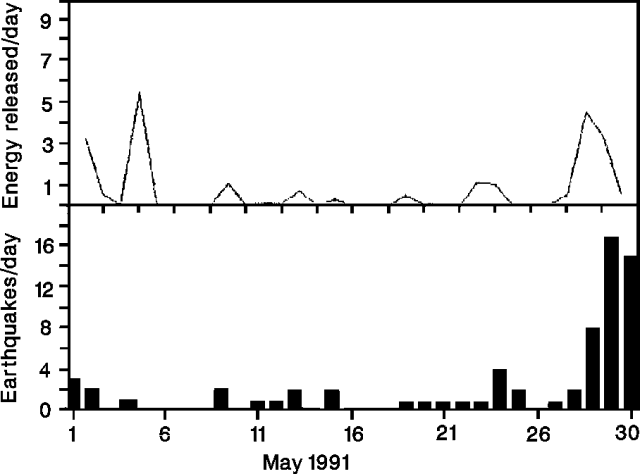Report on Galeras (Colombia) — May 1991
Bulletin of the Global Volcanism Network, vol. 16, no. 5 (May 1991)
Managing Editor: Lindsay McClelland.
Galeras (Colombia) More seismic events but lower energy release; thermal activity remains moderate
Please cite this report as:
Global Volcanism Program, 1991. Report on Galeras (Colombia) (McClelland, L., ed.). Bulletin of the Global Volcanism Network, 16:5. Smithsonian Institution. https://doi.org/10.5479/si.GVP.BGVN199105-351080
Galeras
Colombia
1.22°N, 77.37°W; summit elev. 4276 m
All times are local (unless otherwise noted)
The number of seismic events (high-frequency, low-frequency, and long-period) increased during May, while seismic energy release and reduced displacement decreased from April values (figures 40 and 41). The high-frequency activity (M 0.5-1.9) was centered W of the crater at 2-8 km depth. Tremor episodes were less frequent and had lower reduced displacements than in April. The tiltmeter 0.9 km E of the crater (Crater Station) continued to show deformation, with 20 µrad inflation (tangential component) in May, for a total inflation since September of 102 µrad. Other stations showed oscillations or only very low cumulative inflation.
 |
Figure 40. Daily number of high-frequency events (bottom) and energy release (top) at Galeras, May 1991. Courtesy of INGEOMINAS. |
 |
Figure 41. Daily number of long-period events (bottom) and reduced displacement (top) at Galeras, May 1991. Courtesy of INGEOMINAS. |
SO2 flux, measured by COSPEC, varied between low and moderate levels. Fumarole temperatures in Besolima fissure continued to decrease (436°C in May compared to 468°C in April), while temperatures remained fairly constant at Deformes (254°C compared to 250-265°C since December 1990) and Calvache (89°C compared to 88-92°C since December 1989).
Geological Summary. Galeras, a stratovolcano with a large breached caldera located immediately west of the city of Pasto, is one of Colombia's most frequently active volcanoes. The dominantly andesitic complex has been active for more than 1 million years, and two major caldera collapse eruptions took place during the late Pleistocene. Long-term extensive hydrothermal alteration has contributed to large-scale edifice collapse on at least three occasions, producing debris avalanches that swept to the west and left a large open caldera inside which the modern cone has been constructed. Major explosive eruptions since the mid-Holocene have produced widespread tephra deposits and pyroclastic flows that swept all but the southern flanks. A central cone slightly lower than the caldera rim has been the site of numerous small-to-moderate eruptions since the time of the Spanish conquistadors.
Information Contacts: INGEOMINAS-OVP.

